Atacama
Restauración de arquitectura vernácula.
TESIS DE ARQUITECTURA
Universidad Finis Terrae, 2008, Santiago de Chile
Mi tesis trató sobre el Rescate del Habitar Patrimonial en la Región de Atacama, Chile. Para esto creé una plataforma educativa que busca el intercambio cultural entre locales y extranjeros, a través de la restauración de la arquitectura vernácula del lugar, generando una plataforma para residencias y retiros que pudiera fortalecer y nutrir el patrimonio cultural atacameño, que actualmente se encuentra bajo amenaza.
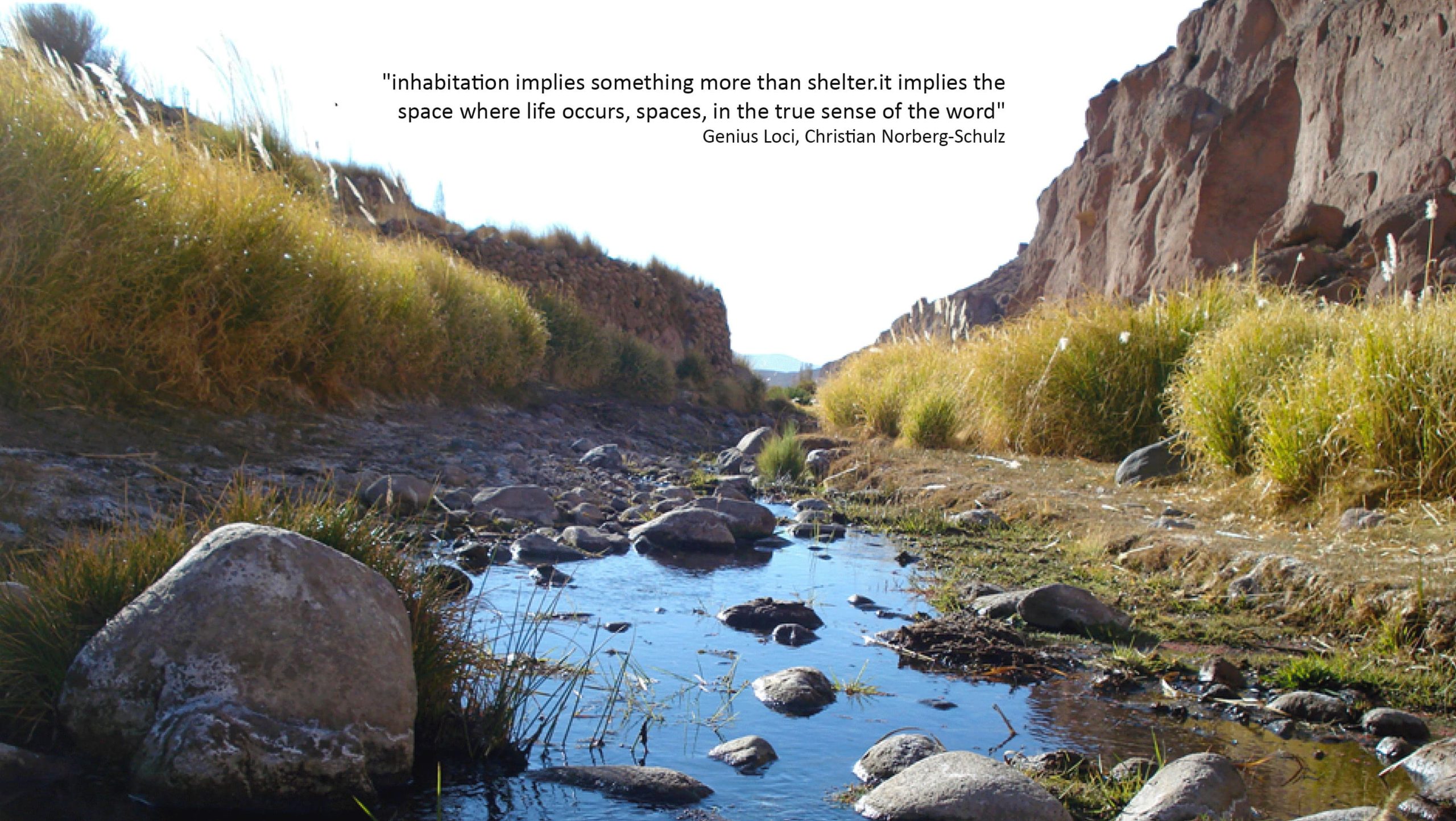
La tesis se origina desde un interés personal en comprender la forma de habitar del hombre sobre la Tierra; en otras palabras, entender la relación que el hombre construye con el territorio y sus diferentes elementos (clima, geografía, agua, tierra, aire, flora y fauna), así como la manera en que una cultura construye, piensa y habita un territorio.
El proyecto se basa en el estudio de una cultura antigua en un territorio inhóspito, lo cual ha permitido que la cultura se mantenga fiel a su desarrollo indígena, debido al poco contacto con culturas foráneas que puedan incorporar otras formas de habitar el territorio en cuestión. Enfoco mi estudio es hacia el Desierto de Atacama en Chile, específicamente, la cultura atacameña, que se ha desarrollado en este territorio desde tiempos prehistóricos.
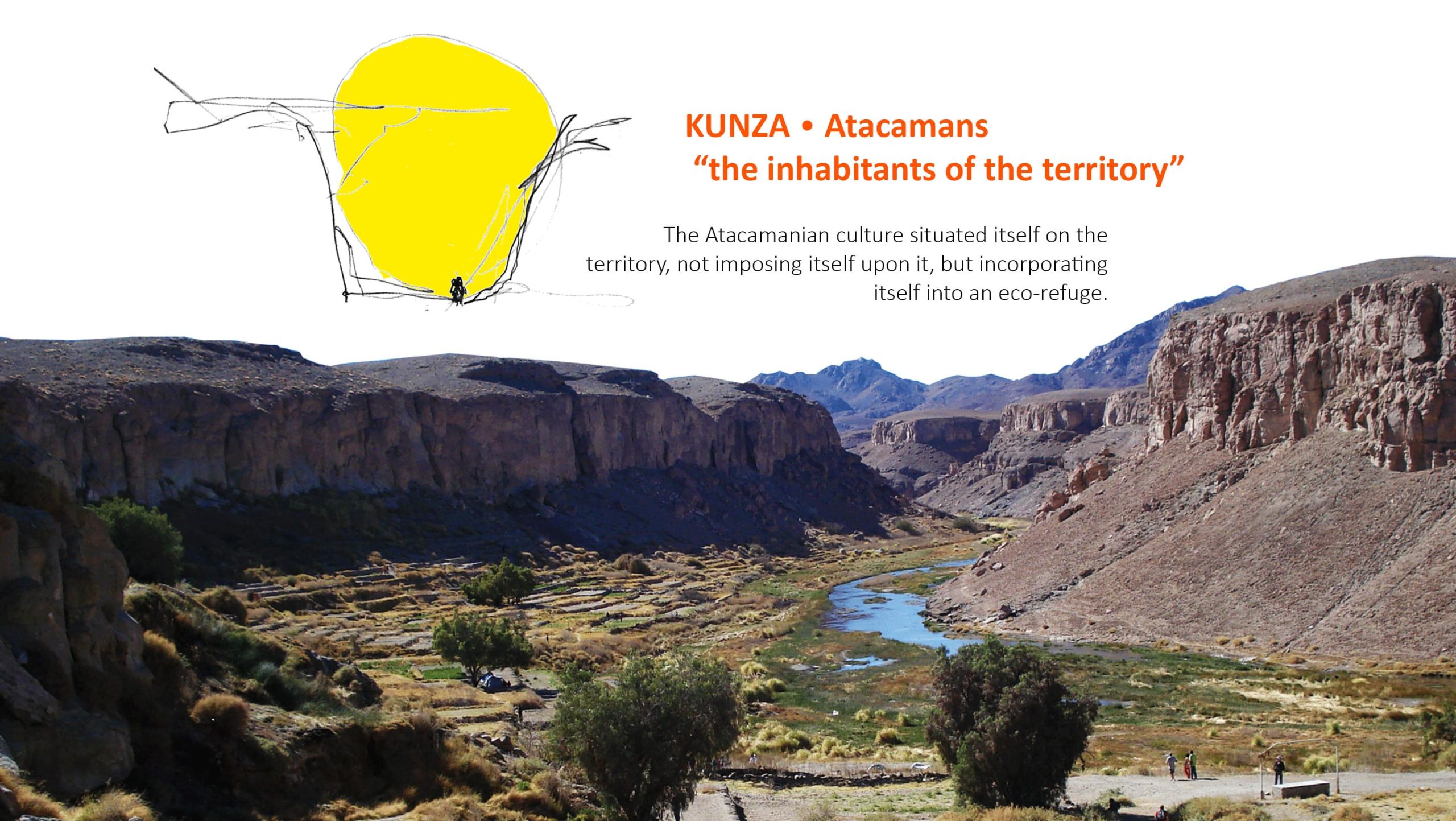
La investigación exploró los cambios físicos de la región debido a un cambio climático de los últimos 10,000 años, mapeó de la ubicación y formas de asentamiento de los atacameños durante su continua adaptación de un paisaje que se está secando. Enfatizando en el detalle constructivo de las viviendas y las relaciones con el territorio. De esta manera, logro desarrollar una línea de tiempo clara y completa respecto a la forma de habitar del hombre en Atacama según clima, historia, cultura y arquitectura, junto con un plano general del área de estudio, que revela la lógica e historia de los asentamientos y la comunicación con el territorio y otras culturas.
El análisis de este estudio revela las ideas y valores de su construcciones y asentamientos, que están profundamente arraigados en el territorio de manera trascendental, reflejados en los dioses de la cultura atacameña, que son elementos que componen el paisaje: Montaña, Agua y Tierra. Entonces viaje al territorio para observar y registrar la realidad actual de la forma de habitar de los atacameños. Visite cada pueblo y ciudad en la región, estudiándolas y extrayendo datos censales de años recientes. La calidad de vida en los pueblos locales contrasta fuertemente con la calidad de vida en las nuevas urbanizaciones, que poseen las tasas de suicidio más altas del país después de Santiago, la capital. Hoy en día, alrededor del 95% de los niños entre 12 y 13 años migran a las ciudades buscando una educación nacional, que promueve su integración a una sociedad global pero no rescata los valores esenciales de sus culturas locales. Esto desarraiga a los niños de sus orígenes.
CASPANA
Provincia del Loa, Atacama, Chile
El proyecto se basa en el diseño de una plataforma para congregación pública en el pueblo de Caspana, el único asentamiento atacameño con crecimiento poblacional, en el cual el habitante local y el extranjero podrán encontrarse dentro de la comunidad con equipamiento adecuado para el desarrollo educativo (museo-talleres-terrazas para cultivo educativo) y encuentros comunicativos (espacios públicos entre las terrazas de cultivo-plaza, auditorio-restaurante) como una forma de generar un círculo de retroalimentación entre visitantes y pobladores, alejándose del formato turístico de “vitrina” que ofrece la situación actual.
La forma de urbanización atacameña surge del orden y canalización del agua; los cursos de agua son las primeras líneas que estructuran el paisaje. Estas líneas se trazan horizontalmente por las faldas de los terrenos inclinados, como una forma de regar los cultivos cuesta abajo. El agua es el elemento fundamental para la supervivencia fundamental y estructural. Así es como el hombre comienza a conquistar el territorio a través de canales de agua, los cuales no solo proveen para los cultivos y el uso doméstico, sino que también organizan y estructuran el territorio. Un nuevo orden se traza sobre el territorio: un orden existencial funcional, necesario para habitarlo y cultivarlo.

Así es como los canales de agua estructuran los asentamientos y configuran el uso del suelo. Los asentamientos atacameños priorizan los terrenos aptos para el cultivo, ubicando sus viviendas sobre tierras no aptas para la siembra y protegidas del viento excesivo de algunos lugares.
Las terrazas agrícolas se localizan de manera continua a lo largo de la quebrada en geometría irregular basada en un rectángulo que se desdibuja para tomar la forma del territorio, la pendiente o la situación específica en la que aparece. Construidas mediante pircas (muros de contención hechos de piedras de forma irregular, nunca más altos de 2m), las terrazas agrícolas crean grandes extensiones de áreas verdes y suelos fértiles en el desierto. Al mismo tiempo, las terrazas de cultivo reducen la escala del paisaje.
Por otra parte, las construcciones atacameñas responden a las necesidades climáticas específicas de una vivienda desértica. Es por esto que se presentan como eco-refugios compactos, aislados de las grandes oscilaciones térmicas diarias.
La forma rectangular es el reflejo de un objeto: un objeto que se posa sobre el territorio como un interior compacto, un objeto que sostiene el aislamiento como su propósito último. Las perforaciones (puertas y ventanas) son escasas y de tamaño reducido, como una forma de evitar el contacto con el exterior y la pérdida de la temperatura interior. Son construcciones oscuras y bajas, con muros gruesos que absorben el calor durante el día y mantienen frescos los interiores, para luego liberarlo durante la noche y proteger a sus habitantes de las bajas temperaturas nocturnas.
Por sobre todas las cosas, la vivienda se estructura como un recinto único y continuo que alberga varios lugares domésticos diferentes a lo largo de su extensión, todos inmersos en un interior común.
La fuerte radiación solar durante el día y las bajas temperaturas nocturnas se materializan en interiores aislados y objetos compactos superpuestos sobre el territorio, los cuales dan paso a la habitación del hombre. Estos interiores se encuentran aislados del exterior, no solo en aspectos climáticos sino también en aspectos espaciales, causando la pérdida de vínculos y comunicación entre un interior funcional domesticado y un exterior extenso e incontrolable. El espacio intermedio nace producto de esta dualidad, como respuesta a una necesidad de habitar no funcional. Se convierte en un hecho arquitectónico que permite el diálogo entre el paisaje y el interior, dando paso al espacio existencial del hombre en el lugar.
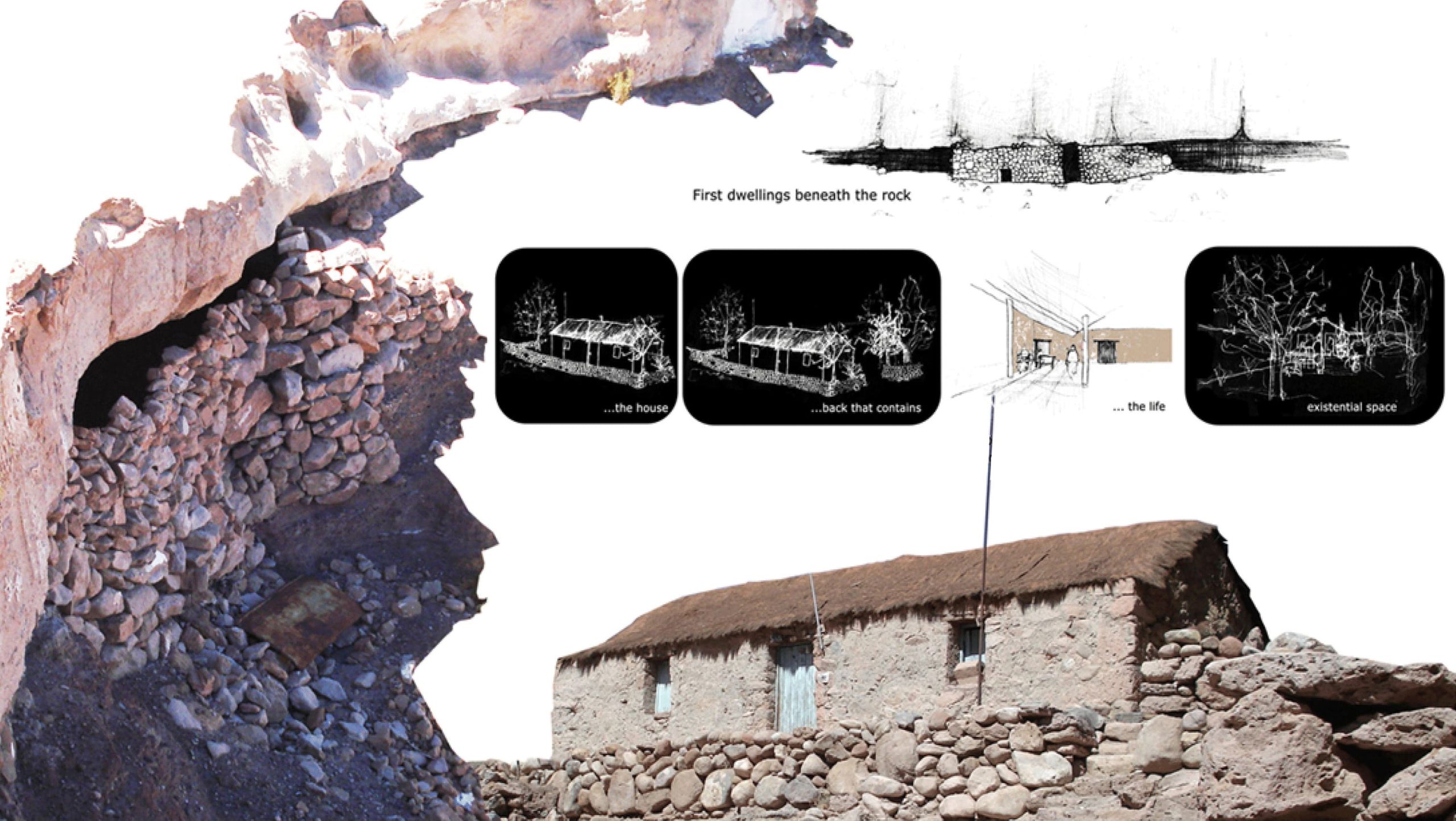
Caspana se ubica a 3300m sobre el nivel del mar, 84 km al norte de la ciudad de Calama, en una quebrada fértil con 47 hectáreas de cultivos. La población del pueblo dedica sus actividades diarias al cultivo de diversas hortalizas y flores que posteriormente se venden en la ciudad de Calama. Caspana no cuenta con una escuela secundaria, por lo tanto, la mayor parte de sus niños migran a Calama a los 12 años de edad. Esta es la mayor causa de migración. Los pobladores requieren otras formas de educación para sus hijos con el fin de asegurar la continuidad de este pueblo y su cultura.
No hay electricidad en Caspana; para iluminarse, dependen de un generador de 7 a 9 pm. Es un pueblo tranquilo, conformado por pastores y agricultores. Cada día, Caspana recibe entre 60 y 200 turistas, quienes no interactúan con los habitantes locales. Esto resulta en una situación donde el pueblo se transforma en una vitrina turística para extranjeros.
La comunidad de Caspana vive en estrecha comunión y equilibrio con su entorno. Sus construcciones están hechas de muros de piedra y techos de barro; el asentamiento está estructurado por un laberinto de canales de agua que lo cruza de este a oeste. El pueblo está prácticamente aislado del exterior, visitado solo tres veces por semana por un automóvil de transporte público que lleva a los pobladores hacia y desde Calama. El pueblo no recibe conexión de telefonía móvil, y posee un único teléfono y acceso a Internet en la Escuela. Tanto la Escuela como el Centro Médico dependen de molinos de viento para obtener energía.
Caspana no posee un sistema de alcantarillado ni un sistema de recolección de basura; a pesar de esto, el pueblo está limpio y es saludable. Los pobladores utilizan agua del río para uso doméstico, y no necesita tratamiento para ser consumida.
Considerando a Caspana como ejemplo de una comunidad atacameña vital y viva, ejemplo de un asentamiento ecológico en el territorio chileno, y evaluando su problema de migración debido a la educación, Caspana se establece como lugar para una propuesta arquitectónica que integre las culturas locales y globales, con el fin de darles a los pobladores de Caspana las herramientas necesarias para su crecimiento, desarrollo futuro y continuidad en el tiempo. Otro objetivo del proyecto es intentar resolver la forma de encuentro entre visitantes extranjeros y pobladores locales, permitiendo que los extranjeros participen y tengan contacto humano con la cultura local.
Entonces, ¿cómo puede ser rescatada una forma ancestral de habitar, profundamente arraigada al lugar y amenazada por la migración?
El objetivo es generar un espacio de encuentro para extranjeros y pobladores locales a través de un proyecto socio-educativo que nutre la cultura local, así como la búsqueda del extranjero en esta localidad.
El proyecto busca ser una plataforma de encuentro y apoyo para dos problemas: a nivel local, el problema de la migración, y a nivel global, la pérdida de la forma esencial de habitar del hombre en un escenario contemporáneo de globalización.
Este es un proyecto sustentable: sustentable en un sentido energético de la palabra, así como en un sentido social y cultural.
Las características volumétricas del proyecto buscan encontrar una forma correcta de abrir un interior compacto hacia un exterior expandido, y viceversa. Este desafío puede ser abordado en múltiples escalas, ya sea a escala macro, debido a la relación del pueblo local en un mundo global actual, así como a escala intermedia, en la cual el proyecto busca generar un espacio público a través de la contención y verticalidad de la quebrada en la horizontalidad extendida del desierto. Finalmente, el proyecto también asume una responsabilidad a escala micro, la cual se refiere a la intención arquitectónica de generar un espacio intermedio como vínculo entre los interiores compactos de una construcción vernácula y la extensión del paisaje.
El proyecto responde a la necesidad de establecer un diálogo fructífero entre las culturas globales y locales, mediante un programa socio-educativo estratégico de una Plataforma de Residencias y Retiros en Caspana. Esta plataforma albergaría los espacios y equipamiento necesarios para desarrollar seminarios internacionales para los profesionales que frecuentemente visitan el Desierto de Atacama con fines académicos y científicos, tales como antropólogos, arqueólogos, astrónomos, geólogos, artistas, arquitectos, geógrafos e historiadores. La plataforma también sería utilizada como refugio para personas que buscan un período de silencio e introspección, o tal vez trabajando en alguna investigación o trabajo específico que requiera aislamiento y paz.
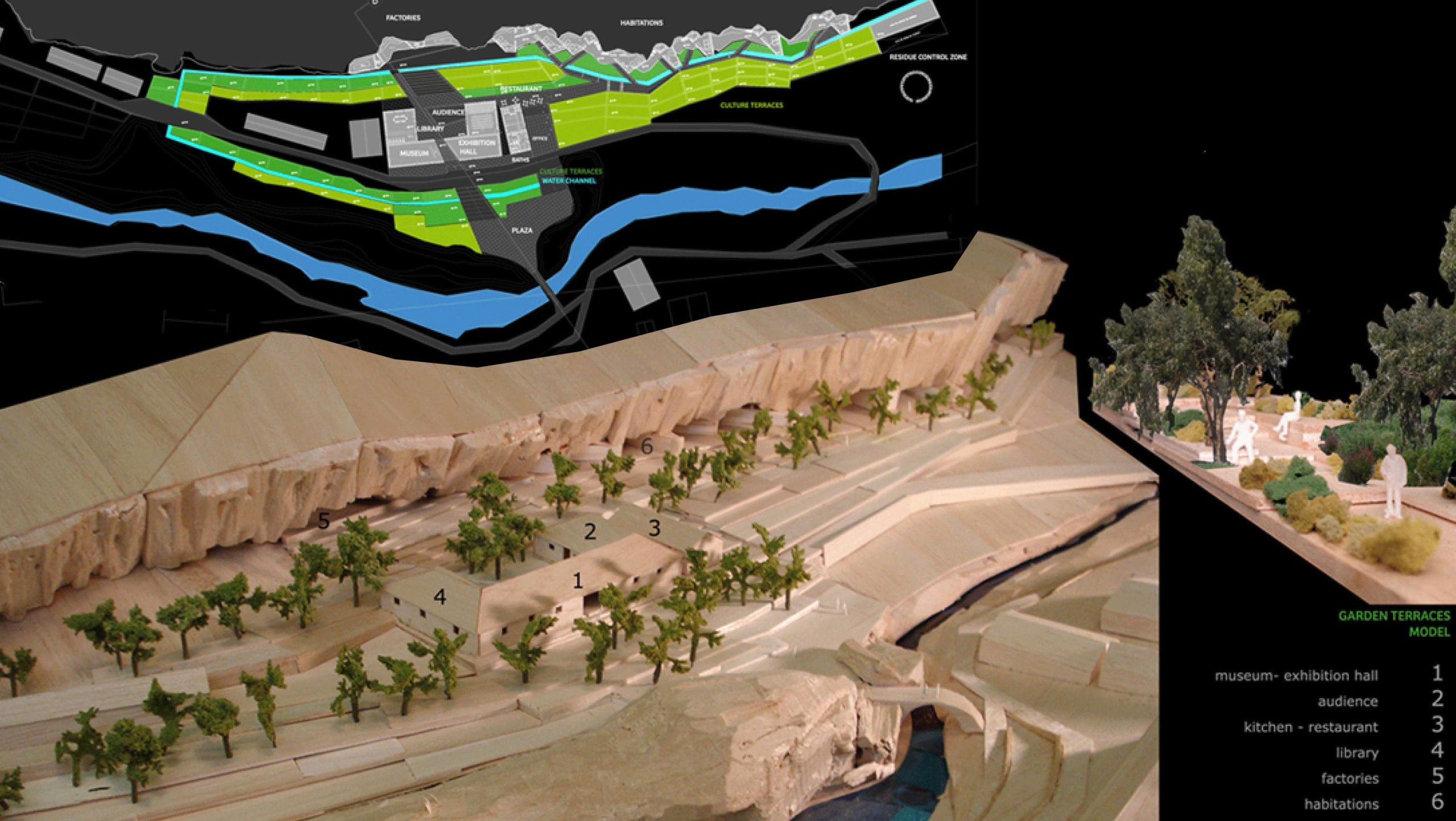
Al mismo tiempo, el equipamiento traído al pueblo por este programa también podría ser utilizado para los fines educativos y comunicacionales de la comunidad de Caspana, conduciendo al desarrollo de un encuentro interactivo entre el visitante extranjero y la gente local. Es una oportunidad para el pueblo de Caspana recibir este equipamiento, ya que podría convertirse en una nueva opción educativa en el futuro. Esto podría disminuir la migración de jóvenes hacia la ciudad, dado que tendrían la oportunidad de desarrollar su educación en su propia comunidad, aprendiendo nuevos idiomas y compartiendo experiencias y talleres con los visitantes extranjeros. Esta nueva propuesta educativa se basa en los estudios de Roberto Hernández, un antropólogo y profesor chileno de la Universidad de Chile, quien trabaja en planes para el Desarrollo y Educación Rural en un contexto global.
El proyecto desarrolla nuevas terrazas de cultivo. Estas serían terrazas públicas enfocadas hacia el desarrollo e investigación del área agraria. Este espacio está destinado para uso comunitario y busca ser un apoyo educativo para la escuela primaria de Caspana. Al mismo tiempo, este espacio público contará con el desarrollo de áreas verdes recreativas, llamadas Jardines en Terrazas, proyectadas para el centro del pueblo. Estas áreas verdes servirán como espacios para encuentros públicos en Caspana.
Es esencial señalar que el emplazamiento de este espacio público se ubica en el cruce entre el eje de las quebradas y la apertura de un eje visual hacia la extensión del desierto. Este punto de vital importancia, donde hoy se encuentra la plaza principal, será reforzado como lugar de encuentro a través de los Jardines en Terrazas, los cuales proporcionarán sombra y diferentes niveles de suelo, llevando tanto a locales como a visitantes a detenerse en este punto. De esta manera, puede tener lugar un encuentro humano y natural entre atacameños y extranjeros, rompiendo la situación de vitrina en la que se encuentra actualmente el pueblo debido a las visitas de buses llenos de turistas, la mayoría de los cuales no tiene idea de dónde están y por lo tanto observan la realidad local desde un plano abstracto.
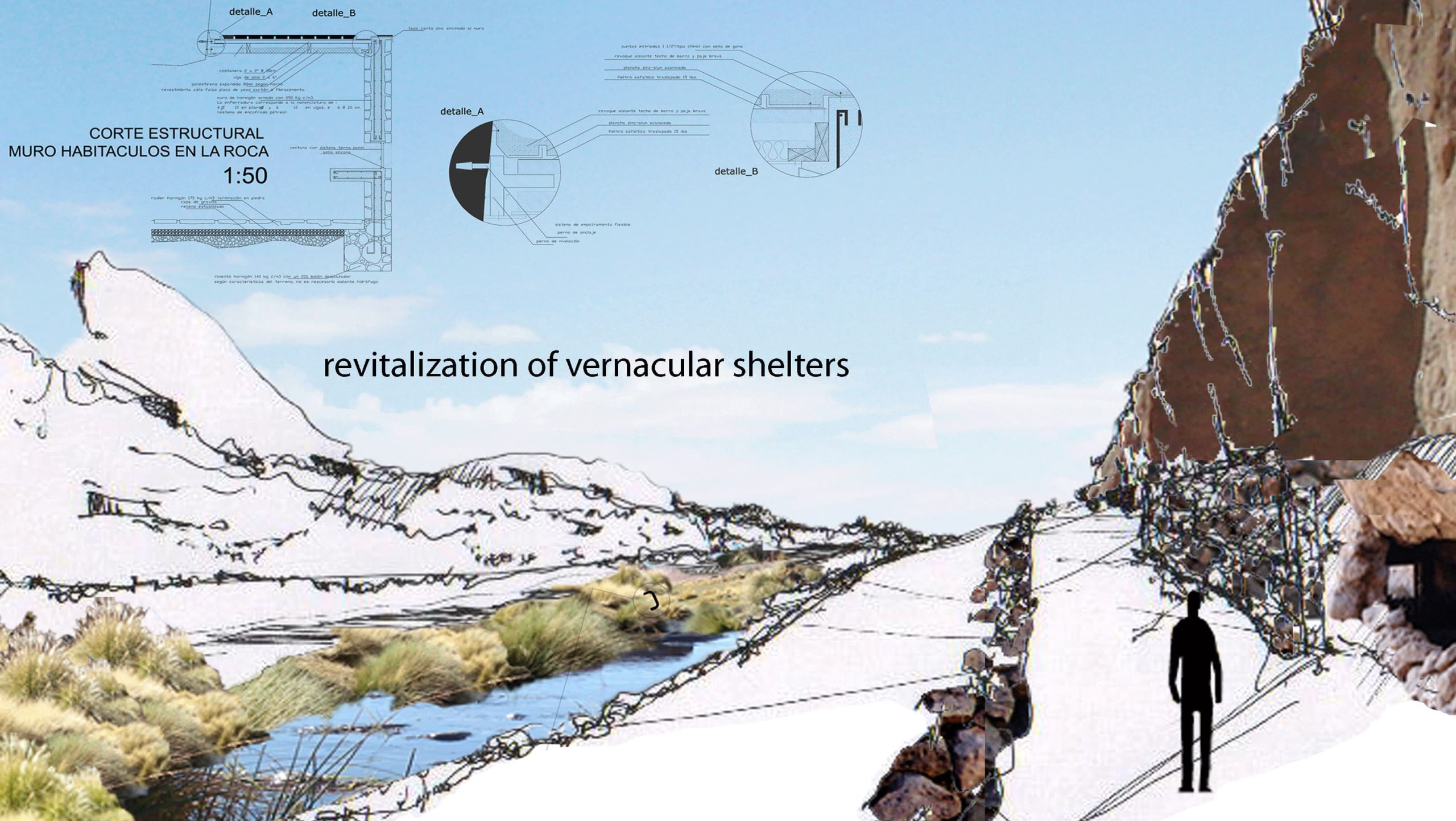
Finalmente, el proyecto pretende restaurar y construir el siguiente programa.
PARTE DEL PROYECTO (restauración y nuevas construcciones)
- Prolongación del antiguo canal de riego en la ladera norte (restauración)
Como origen del proyecto, se rescata y prolonga el antiguo canal de riego del norte con el fin de llevar agua y fertilizar los terrenos en el centro del pueblo, donde se ubicará el proyecto arquitectónico.
- Terrazas de cultivo comunitarias experimentales (nuevo)
Se proyectan 49 terrazas de cultivo para uso comunitario con el fin de estimular el desarrollo, la educación y la experimentación de la actividad agraria.
- Jardines en Terrazas (nuevo)
Se proyectan 37 Jardines en Terrazas con el fin de albergar espacio público para el pueblo en una espacialidad intermedia, proporcionando sombra y ubicados entre la Plaza de Encuentro y los accesos a los diferentes edificios del programa.
- Plaza de Encuentro (restauración)
Una plataforma abierta dentro de la quebrada que se extiende hacia el horizonte del desierto a través de la apertura visual del eje de acceso, perpendicular a la terraza.
- Auditorio/Sala de conferencias (nuevo programa en la restauración del museo)
Tiene capacidad para 60 personas, con posibilidad de proyecciones al aire libre para el pueblo.
- Cocina y Restaurante (nuevo programa en la restauración de la casa comunitaria)
Una cocina que puede albergar cursos de cocina local y un restaurante para 36 personas.
- Biblioteca y Zona de Estudio (nuevo programa en la restauración del museo)
Computadora, libros, documentales y una mesa de estudio.
- Museo de Caspana y Sala de Exposiciones Temporales (nuevo programa en la restauración del museo)
Un museo de Caspana y una sala para exposiciones temporales, ya sea de artistas locales, artistas extranjeros o exposiciones de arte chileno.
- Talleres (nuevo programa en la restauración de las antiguas bodegas de alimentos)
Las bodegas se abren para albergar talleres de tejido, adobe u otros talleres necesarios.
- Habitaciones en la Roca (restauración)
Restauración y construcción de viviendas antiguas; estas se transforman en 8 habitaciones, cada una con cama doble, baño, cocina y sala de estar.
*Por favor, note que este proyecto ha sido desarrollado como una Tesis de Arquitectura para mi título profesional de Arquitectura en la Universidad Finis Terrae en Chile. Y todos los planos, detalles e información técnica creados como entrega final permanecen privados como un acuerdo personal con la comunidad local de Caspana. Este proyecto no fue construido, pero espero que algún día en el futuro Caspana pueda tener un lugar así, son simplemente gente hermosa que merece lo mejor.
